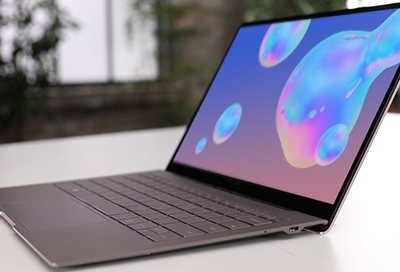Lock screen options on Samsung PCs running Windows

Lock screen options on Samsung PCs running Windows
Set up a Lock screen
Create a regular password
Create a traditional password using letters, numbers, and symbols to stop anyone from using your PC without permission.
- Select the Start icon, then select Settings, and then select Accounts.
- Select Sign-in options, select Password, and then select Add.
- Create your new password and password hint, and then select Next. Keep in mind that your password must be at least 8 characters long.
- Select Finish. Now you can lock the screen and sign in using your password.
Once you have a Lock screen set up, you can use the Samsung Flow app to unlock your PC using your Galaxy phone. If you need to reset a forgotten Microsoft Account password, see Microsoft's guide for troubleshooting.
Make a picture password
If you are more of a visual person, you can create a picture password that is made out of a combination of circles, lines, and taps. This picture will pop up on your sign-in screen when you turn on your PC.
- Select the Start icon, then select Settings, and then select Accounts.
- Select Sign-in options, select Picture Password, and then select Add.
- Enter your account password, and then select OK.
- Next, select Choose picture and navigate to the picture you would like to use. Select Open.
- Drag the picture to the desired position, and then select Use this picture. Or, select Choose a new picture if you change your mind.
- Once you’ve chosen a picture, draw directly on the touchscreen to create a combination of circles, straight lines, and taps that will act as your password. The size, position, and direction of your gestures will become part of your picture password.
- Repeat the three gestures, and then select Finish.
Use a PIN password
Numerical PINs are a fast, easy, and secure way to make sure no strangers get into your PC.
- Select the Start icon, then select Settings, and then select Accounts.
- Select Sign-in options, select PIN (Windows Hello), and then select Add.
- Enter your account password, and then select OK.
- Enter a new PIN, re-enter the PIN, and then select OK. Your PC’s password will now change to the new PIN you just created.
Create a fingerprint password
Select PCs such as the Galaxy Book 2, Galaxy Book S, Galaxy Book Pro, and Galaxy Book Pro 360 all include a fingerprint sensor, which can be used to sign into your account. This extra layer of security will ensure that only you can access your device. On the Galaxy Book 2, the fingerprint sensor is located on the back of the PC in the upper left-hand corner. On the Galaxy Book S, Galaxy Book Pro, and Galaxy Book Pro 360, it's located on the Power button.
- Select the Start icon, then select Settings, and then select Accounts.
- Select Sign-in options, select Fingerprint recognition (Windows Hello), and then select Set up.
- Select Get started, and then press your finger on the fingerprint sensor. Follow the prompts to set up your fingerprint.
- If prompted, create or enter your login information to finish the setup. Or, you can select Add another finger to use more than one fingerprint when signing in.
Use Dynamic lock
With Dynamic lock, your phone can become the key to your PC! In other words, if a paired phone is out of range, Windows will automatically lock your PC. But first, you'll need to connect the phone and PC through Bluetooth.
- First, make sure Bluetooth is activated on your phone. On your PC, select Start, begin typing Dynamic lock, and select it when it appears.
- Expand the Dynamic lock drop-down if needed, and then select Allow Windows to automatically lock your device when you’re away.
- Next, select Bluetooth & other devices, and then select the switch to turn on Bluetooth.
Note: You can skip this step if you know Bluetooth is already turned on or if you're using Windows 11. - Once your PC detects your phone, it should pair automatically. However, if your PC is having trouble finding your phone, select Add Bluetooth or other device, and then select Bluetooth.
Customize a Lock screen
Lock screen background
The most recognizable and noticeable feature of the Lock screen is the background. You can change the background to your favorite photo, a slideshow, or a Windows spotlight.
Select the Start icon, then select Settings, and then select Personalization. Select Lock screen, then select the drop-down menu next to Personalize your lock screen, and choose the desired setup:
- Windows spotlight: Displays photography from around the world and is updated daily. You also get tips and tricks for getting the most out of Windows.
- Picture: Choose your own picture as the Lock screen background.
- Slideshow: Choose a photo album for your slideshow.
Lock screen apps
Lock screen apps run in the background when your PC is locked. Selecting a Lock screen app allows you to receive status updates and notifications from the app. For example, if you select the email app, you will get notifications that you have a new email even when your PC is locked.
Select the Start icon, then select Settings, and then select Personalization. Select Lock screen, then select the drop-down menu next to Lock screen status, and then select your desired app.
Password options
Create or change a local account password
If you are not a Microsoft account user, you can still access your Windows PC through a local account. You can add or change a local password whenever you need to.
- Select Start, begin typing Your account info, and then select it when it appears.
- Verify that you are signed in with a local account. If not, select Sign in with a local account instead, and follow the on-screen instructions. You will be asked to sign out of your Microsoft account.
Note: Depending on your settings, Windows 11 may say "Stop signing into your Microsoft account automatically" instead. Select this to sign out of your Microsoft account. Then, repeat Steps 1 through 3 again. - If you ever need to create a new local account password, navigate to Accounts again, and then select the Sign-in options tab.
- Select Password, select Add, and then follow the on-screen prompts.
- Or, to change your current local account password, navigate back to Accounts in the Settings menu, then select Sign-in options, and then select Password. Select Change, and then follow the on-screen prompts. You can also remove the password by changing it and then leaving the new password blank.
Create or change a Microsoft account password
A Microsoft account is a PC account that uses your Microsoft email. Signing into a Microsoft account allows you to access a special cloud service. Your data, such as contacts, will sync to the cloud and to other connected devices, including on iOS and Android. You can change your Microsoft account password directly from your Windows PC. If you do not have a Microsoft account, you can create one on the Microsoft website.
- When you want to change your password, select Start, and then select Settings.
- Select Accounts, and then select Your info.
- Verify that you are signed in with a Microsoft account. If not, select Sign in with a Microsoft account instead.
- Sign in to your Microsoft account using the on-screen instructions.
- If you ever need to change your current Microsoft account password, navigate back to Accounts in the Settings menu. Select Password, select Change, and then follow the on-screen prompts to change your Microsoft account password.
Note: You cannot remove a Microsoft account password completely or change your Microsoft password directly on a Windows PC. You will need to change it from the Microsoft website.
Recover a forgotten password
If the password you've forgotten is for your Microsoft account, please visit Microsoft's password reset site to recover it.
Or, if the password you've forgotten is for your Administrator account, follow the steps below:
- Log into a different Administrator account.
- Use the PC’s search bar to search for and select Control Panel.
- Select User Accounts, and then select User Accounts on the next screen as well.
- Select Manage another account, and select the account you need to change.
- Select Change the password, and follow the on-screen prompts to change the password.
- Finally, select Change password to confirm your changes.
Lock screen options for Chromebooks



Contact Samsung Support




